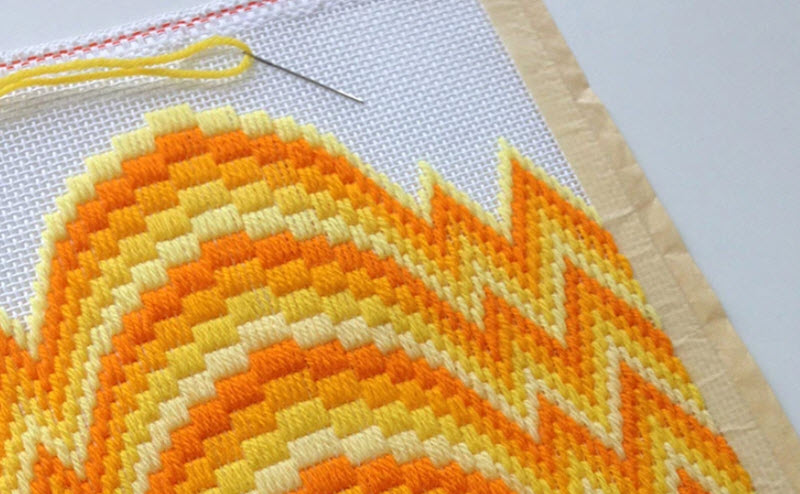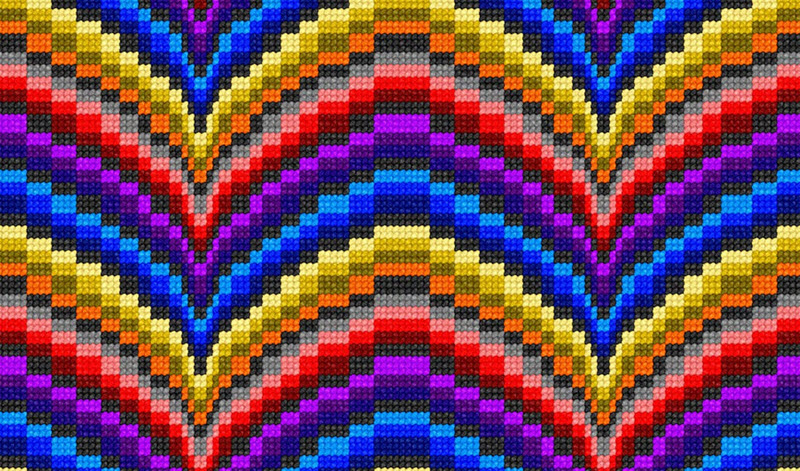Contents

Bargello is a type of needlepoint embroidery where upright flat stitches are placed in a pattern to form images. In traditional bargello, a stitch will typically go over at least two threads, but some contemporary bargello artists have experimented with breaking this convention.
Historically, bargello embroidery was often selected to adorn items that would have to withstand a lot of wear and tear – such as carpets and upholstered armchairs – because a well-made bargello embroidery is very durable. Back then, bargello was always stitched on canvas using wool yarns. The designs were often very colorful and contained many different hues to produce complex shading effects.
Bargello embroidery is associated with geometric patterns where the embroider places every stitch with mathematical precision.
Examples of classic bargello motif styles
- Flame: Sharp motifs where the stitches are stepped sharply. Sharp points and zig-zag patterns are common.
- Diamond: Sharp motifs where the stitches step sharply and color changes are employed to create diamond-shaped figures.
- Medallions: Curved motifs where the stitches are stepped slowly and gradually, and color changes are employed to create medallion-shaped figures or spheres.
- Ribbonsri: Curved motifs where the stitches are slowly and gradually stepped and different colors are used.
Modern four-way bargello art
In the 20th century, bargello artists started to experiment and try out alternatives to the classic style where all stitches are vertical and goes in one directly only. In the 1960s, four-way bargello embroidery began to appear, a style where you divide the canvas diagonally into quarters before you start embroidering. The same motif is embroidered using horizontal stitches in two quarters opposite from each other, while the other two quarters are embroidered using vertical stitches. One of the pioneers was Dorothy Kaestner, whose helped popularize four-way bargello art in the 1970s.
From the four-way bargello, the eight-way bargello was developed. Eight-way bargello have vertical, horizontal and diagonal stitching.
Why is it called Bargello?
This type of needlepoint embroidery is named after Palazzo del Bargello in Florence, Italy, because of a series of chairs found there. These chairs, which were made in the 1600s, have both their seats and backs adorned with needlepoint in the flame stitch pattern.

Origins
We do not know how old the bargello tradition is or where it started, and it is not believed to have been invented at Palazzo del Bargello. There are some indications that Queen Jadwiga of Poland, who lived in the 14th century and was a native of Hungary, did Bargello work. In Italian, bargello embroidery has traditionally been called punto unghero, Hungarian needlepoint, hinting of Hungary as its source, at least from the Florentine/Italian perspective. One fairly old source claims that a Hungarian princess who married a man from the Medici family introduced it to Florence.
Doing Bargello needlepoint art
For classical bargello, the most common basic unit is a vertical stitch of four threads. It is common for all stitches to be of the same height, but some artists break with this convention – and this rebellious act can even be observed in some very old European bargello pieces that have survived into our time.
In classic bargello works, the pattern has been created with hue changes and by letting vertical stitches be offset vertically – a process called stepping. Typically, two threads are offset at the time when four threads are used for the basic unit.
